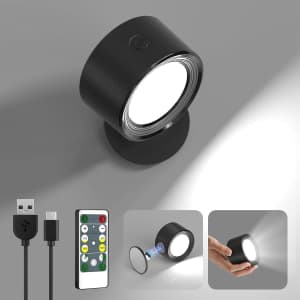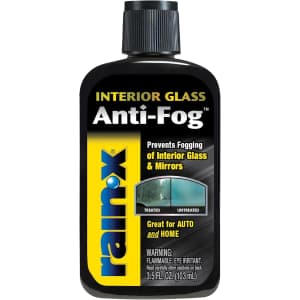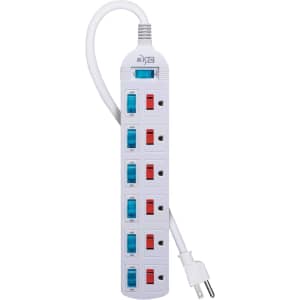
Here you'll find a bunch of cheap clearance items priced at $1 or less as part of Amazon Haul's $1 Flash Deals Sale. Customers are limited to three flash deals each. Shipping is free on Amazon Haul orders of $25 or more. Buy Now at Amazon

Get this price in charcoal or blue. Perfect Fit Rewards members get free shipping on all orders (it's free to join). Buy Now at Men's Wearhouse

Shop hex keys from around $4, cutters from below $10, plus multimeters, screwdrivers, pliers, and much more. Buy Now at Amazon

Save $169 off the list price. Bank Account members get free shipping (it's free to join). Buy Now at Jos. A. Bank

That's a $6 low. Buy Now at Amazon
- 0.3, 0.5, 0.7, 0.9, and 2.0mm
- includes five pencils, six lead refills, and 10 eraser refills
- Model: TCAE005M237

It's the best price that Amazon has charged for this parking mat. Buy Now at Amazon

Apply coupon code "XD6FV3FY" for a total savings of $11. Buy Now at Amazon
- insulated with 3M Thinsulate
- high-density brushed fleece lining
- wind-resistant & water-repellent exterior
- conductive fibers across every fingertip to be touchscreen compatible
- one-hand adjustable drawcord

Save $25 on this 1-year subscription, offering you ad-free learning with unlimited hearts, offline lessions, personalized practice, and more. Note that this offer is eligible for users without an active paid subscription; if you do, wait for it to expire before redeeming this deal.
Take a look at all our Duolingo Promo Codes for more savings and deals. Buy Now at StackSocial

That's a savings of $4. Buy Now at Amazon

It's a great deal for a generic eletric snow shovel. Buy Now at Amazon

From just $11, you can get an appetizer, entree, and beverage. Check the page for a list of what's involved in each. Price may vary by location. Buy Now at Chili's

Get stacked savings on up to 15 pairs via promo codes "EXTRA50" and "UA15". We've pictured the Under Armour Men's UA Valsetz RTS 1.5 Tactical Boots for $46.73 after codes ($78 savings). Shipping is free over $50, otherwise it adds $8. Buy Now at Under Armour


We've pictured this 36" Pickup and Reach Tool for $2 ($2 off). Some items are in-store only. Shipping starts at $6.99. Buy Now at Harbor Freight Tools

That ties the lowest price we've seen. Buy Now at Amazon
- 500W power output
- 12V AC generator
- Starts at 2.5m/s wind speed
- 47" rotor diameter
- Die-cast aluminum body

Save $400 off the list price on this wool jacket. Perfect Fit Rewards members get free shipping on all orders (it's free to join). Buy Now at Men's Wearhouse

Eco-Worthy US via eBay offers the Eco-Worthy 30.72kWh 48V 100AH Server Rack Lithium Battery 6-Pack with Monitor for $4,679.99 (reduced from $5,179.99) with free shipping via coupon code "NEWFAVE15". Buy Now at eBay
- wireless connectivity and smart monitoring
- fits standard 3U cabinets
- durable full-metal shell and a 100A BMS that provides multiple layers of protection

It's the best price that Amazon has charged for this organizer. Buy Now at Amazon

T-shirts start at $7, jeans are from $22, jackets start at $25, and much more. We've pictured the Hollister Men's Faux Fur-Lined Puffer Jacket for $39.99 ($80 off). Shipping adds $7, but Hollister House Rewards members get free shipping with orders of $59 or more. (It's free to join.) Buy Now at Hollister

That's a 42% savings. Buy Now at Amazon
- 200W peak power output
- Dual channel audio receiver
- Multiple inputs including USB and Bluetooth
- EQ controls for sound customization
- Built-in digital LED display
- Model: PDA29BU.5

Apply coupon code "7LD7FS5N" for a savings of $335. Buy Now at Amazon
- 108-inch oversize sectional
- Plush, durable velvet fabric
- Six modular configurations
- 68.5-inch chaise for relaxation
- No assembly required

Clip the $4.80 off coupon on the page and apply code "RJQ3AM57" for a savings of $16. Buy Now at Amazon
- 360° rotation magnetic ball
- 3,000mAh rechargeable battery
- three color temperatures

Apply coupon code "WX3NMTSO" for a total savings of at least $25. Buy Now at Amazon
- Adjustable strap system
- Mesh pocket for holding small items like keys or a phone

The price drops via a combination of a Prime membership discount, on-page clip coupon, and additional discount at checkout. Buy Now at Amazon

Promo code "GLOWUP30" takes $30 off orders of $90 or more - letting you stock up on stress relief, sleep aids, and focus boosts as we head into 2026. Plus, all qualifying orders ship free. Buy Now at Sunday Scaries

Apply coupon code "NWXNIEJ5" for a savings of $71. Buy Now at Amazon
- Modular design for flexible layouts
- High-density foam for firm support
- Includes one firm and one soft pillow
- Plush velvet upholstery
- No assembly required

You'd pay over $20 for something similar elsewhere. Buy Now at Amazon

You'd pay $30 more elsewhere. Buy Now at Amazon

Apply coupon code "FFJO4IFY" for a savings of $100. Buy Now at Amazon
- Seats 4-6 people
- MDF ensures a strong tabletop
- Measures 70.87" L × 35.43" W
- Base offers exceptional stability
- Supports up to 300 lbs.

You'd pay over $20 elsewhere. Buy Now at Amazon

That's the best price we could find by $2. Buy Now at Amazon

Get 7 pairs of Victoria's Secret panties for $35 during the current Panty Party. That's $5 per pair and a savings of up to $10 off each. Victoria's Secret Rewards members get free shipping with orders of $50 or more, and it's free to join.

This Amazon Lightning Deal won't last long, so move quick if you want to save $70. The heated vest is available in a few sizes and comes iwth a battery pack. It ships for free for Prime members, too. Buy Now at Amazon
- Instant heating with 3 settings
- 6 heating zones for warmth
- Fleece and polyester fabric
- Battery lasts up to 9 hours
- Machine washable design

It's $670 off and the lowest price we could find. Buy Now at Newegg
- AMD Ryzen 7 5700G 3.8GHz 8-Core CPU
- 16GB RAM; 1TB SSD
- Windows 11 Home

DigitalKeysBox offers the Windows 11 Pro + Microsoft Office Pro 2024 Bundle for $12.99 (reduced from $368.99) with promo code "DNEWS_BUNDLE" applied in cart.
Includes Windows 11 Pro (Lifetime):
- Lifetime activation — no subscription or renewal fees.
- Clean installation and online activation supported.
- Suitable for home, work, or business use.
- Compatible with Windows 10 and Windows 11 systems.
Includes Microsoft Office Pro 2024 (Lifetime):
- Lifetime license for 1 PC (Windows 10/11).
- Includes Word, Excel, PowerPoint, Outlook, OneNote, and Access.
- Instant email delivery — download and activate today.
- One-time purchase — no subscription required.

Promo codes "EXTRA50" and "UA15" get the pair at a $43 savings. Shipping is free over $50, otherwise it adds $8. Buy Now at Under Armour



Apply coupon code "XZ3YWVRA" for a savings of $14. Buy Now at Amazon
- Measures PM2.5, temperature, and humidity
- Fast 2-second data refresh
- LED display with air quality levels
- Connects to GoveeHome appliances
- WiFi and Bluetooth enabled

Apply coupon code "CUEQ2RMV" for a savings of $4. Buy Now at Amazon
- supports most fast charging protocols
- nylon-braided
- Model: CATWJ-01

Add three of these 12-packs to your cart via Subscribe & Save to get them for this price and save $9 compared to buying this quantity elsewhere. Buy Now at Amazon

Save $45 off the list price. Choose pickup or spend $75 to avoid the $8 shipping charge. Buy Now at L.L.Bean

That's $50 off and the best price we've seen. Buy Now at Walmart

It's the best price we've seen for this 10-pack and a great deal for a 10-pack of women's briefs in general. Buy Now at Amazon

Eco-Worthy US via eBay offers the Eco-Worthy 30.72kWh 48V 100AH Server Rack Lithium Battery 6-Pack with Monitor for $4,679.99 (reduced from $5,179.99) with free shipping via coupon code "NEWFAVE15". Buy Now at eBay
- wireless connectivity and smart monitoring
- fits standard 3U cabinets
- durable full-metal shell and a 100A BMS that provides multiple layers of protection
How Much Can I Save on the Hottest Deals?
The average savings can vary wildly day by day, but we regularly see discounts of anywhere from 15% to 96% off. The biggest discounts usually pop up for holidays, such as these Early Prime Day Deals. Thanks to coupon codes giving extra discounts, we'll regularly see shoes and apparel from the biggest brands like Nike, adidas, and New Balance at over 50% off. If you're looking for tools or home improvement, we see deals from stores like Home Depot and Lowe's that take up to 70% off. Plus, if something's at its best-ever price, or close to it, or is just something we think is extra neat, you'll probably find it on our Staff Picks page.
How Often Are the Hottest Deals Updated?
Around the clock! An international team of highly-trained deal jockeys is constantly scouring Amazon, Walmart, Best Buy, Target, and any other store you care to name, seeking out the latest and greatest deals for you to peruse. From daily deals and doorbusters to niche finds and off-the-wall offers, our pages are always being updated with something new and interesting and discounted.




